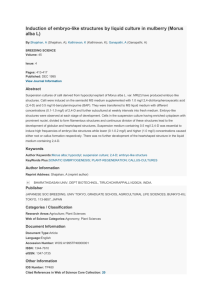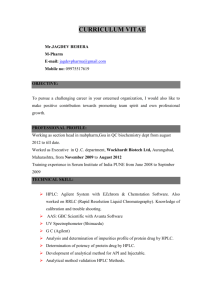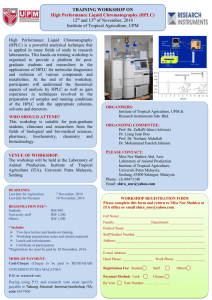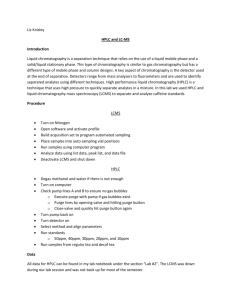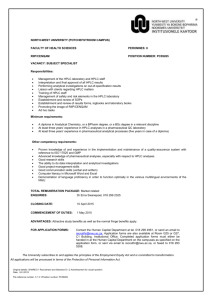PS - Springer Static Content Server
advertisement
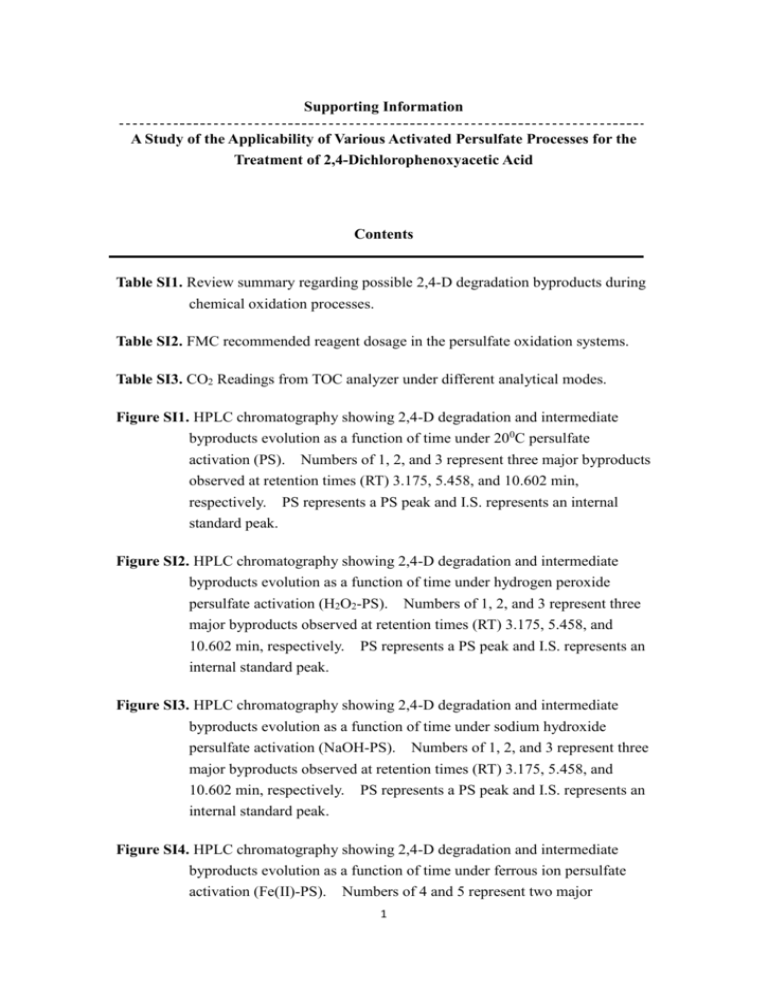
Supporting Information A Study of the Applicability of Various Activated Persulfate Processes for the Treatment of 2,4-Dichlorophenoxyacetic Acid Contents Table SI1. Review summary regarding possible 2,4-D degradation byproducts during chemical oxidation processes. Table SI2. FMC recommended reagent dosage in the persulfate oxidation systems. Table SI3. CO2 Readings from TOC analyzer under different analytical modes. Figure SI1. HPLC chromatography showing 2,4-D degradation and intermediate byproducts evolution as a function of time under 200C persulfate activation (PS). Numbers of 1, 2, and 3 represent three major byproducts observed at retention times (RT) 3.175, 5.458, and 10.602 min, respectively. PS represents a PS peak and I.S. represents an internal standard peak. Figure SI2. HPLC chromatography showing 2,4-D degradation and intermediate byproducts evolution as a function of time under hydrogen peroxide persulfate activation (H2O2-PS). Numbers of 1, 2, and 3 represent three major byproducts observed at retention times (RT) 3.175, 5.458, and 10.602 min, respectively. PS represents a PS peak and I.S. represents an internal standard peak. Figure SI3. HPLC chromatography showing 2,4-D degradation and intermediate byproducts evolution as a function of time under sodium hydroxide persulfate activation (NaOH-PS). Numbers of 1, 2, and 3 represent three major byproducts observed at retention times (RT) 3.175, 5.458, and 10.602 min, respectively. PS represents a PS peak and I.S. represents an internal standard peak. Figure SI4. HPLC chromatography showing 2,4-D degradation and intermediate byproducts evolution as a function of time under ferrous ion persulfate activation (Fe(II)-PS). Numbers of 4 and 5 represent two major 1 byproducts observed at retention times (RT) 5.317 and 5.726 min, respectively. PS represents a PS peak. Figure SI5. HPLC chromatography showing 2,4-D degradation and intermediate byproducts evolution as a function of time under 700C persulfate activation (T-PS). Numbers of 1 and 2 represent two major byproducts observed at retention times (RT) 3.175 and 5.458 min, respectively. PS represents a PS peak and I.S. represents an internal standard peak. Figure SI6. HPLC chromatography showing 2,4-Dichlorophenol analysis using HPLC method #1. (a) water only sample; (b) 2,4-Dichlorophenol sample (0.307 mM). Figure SI7. HPLC chromatography showing 2,4-Dichlorophenol analysis using HPLC method #2. (a) water only sample; (b) 2,4-Dichlorophenol sample (0.307 mM); (c) Fe(II)-PS experiment (reaction time = 1 hr). Numbers of 4 and 5 represent two major byproducts observed at retention times (RT) 5.317 and 5.726 min, respectively. PS represents a PS peak. Figure SI8. Persulfate and hydrogen peroxide decomposition as a function under various persulfate activations. Experimental conditions: Temp. = 20oC (except for T-PS system Temp. = 70oC) and fixed [PS] = 100 mM; [H2O2] = 300 mM; [NaOH] = 50 mM; [Fe] = 10 mM. Figure SI9. Total iron and ferrous ion concentrations as a function of time during iron activated persulfate reaction. Experimental conditions: Temp. = 20oC; [Fe] = 10 mM and [PS] = 100 mM. Figure SI10. 2,4-D degradation byproduct formation as a function of time for experiments of iron activated persulfate oxidation under various ferrous ion concentrations. Fe2+/S2O82- molar ratios of (a) 20/100, (b)10/100, (c)5/100, (d)1/100, and (e)0.5/100。Note: Quantities of byproducts are measured using HPLC/UV detector responses, i.e., mAU*s: mili absorbance unit * second. Experimental conditions: Temp. = 200C. Figure SI11. 2,4-D degradation byproduct formation as a function of time for experiments of iron activated persulfate oxidation under various persulfate concentrations. Fe2+/S2O82- molar ratios of (a) 10/100, (b)5/100, (c)10/10, (d)5/5, (e)10/5, and (f)5/2.5。Note: Quantities of byproducts are measured using HPLC/UV detector responses, i.e., mAU*s: mili 2 absorbance unit * second. Experimental conditions: Temp. = 200C. 3 Table SI1. Review summary regarding possible 2,4-D degradation byproducts during chemical oxidation processes. Reaction time (min) Byproducts Oxidant Catalyst Literature Processes Initial 2,4-D (mg/L) 1 Photoelectro-Fenton 100 300 H2O2 FeSO4 ○ 2 Photoelectro-Fenton 230 360 H2O2 FeSO4 ○ 3 Photo-Fenton 500 60 H2O2 FeSO4 2,4-DCP 2,4-DCR 4,6-DCR 2-CHQ 2-CBQ CHQ 2,4,6-TCP ○ ○ ○ ○ ○ ○ ○ Fe2(SO4)3 4 Sono-electrochemical 55-332 10 H2O2 FeSO4 ○ 5 AOP review based on hydroxyl radical - - - - ○ 6 O3/UV/TiO2 10 120 O3 TiO2 ○ 7 PMS/Co 100 45 8 Oxone/Co 2,4-DCP (50) 240 NaHSO5 Co(AcO2)2 Oxone CoCl2 ○ ○ ○ ○ ○ ○ References: 1. Badellino, C.; Rodrigues, C.; Bertazzoli, R., Oxidation of herbicides by in situ synthesized hydrogen peroxide and fenton’s reagent in an electrochemical flow reactor: study of the degradation of 2,4-dichlorophenoxyacetic acid. Journal of Applied Electrochemistry 2007, 37 (4), 451-459. 2. Brillas, E.; Calpe, J. C.; Casado, J., Mineralization of 2,4-D by advanced electrochemical oxidation processes. Water Research 2000, 34 (8), 4 2253-2262. 3. Kwan, C. Y.; Chu, W., Photodegradation of 2,4-dichlorophenoxyacetic acid in various iron-mediated oxidation systems. Water Research 2003, 37 (18), 4405-4412. 4. Yasman, Y.; Bulatov, V.; Gridin, V. V.; Agur, S.; Galil, N.; Armon, R.; Schechter, I., A new sono-electrochemical method for enhanced detoxification of hydrophilic chloroorganic pollutants in water. Ultrasonics Sonochemistry 2004, 11 (6), 365-372. 5. Peller, J.; Wiest, O.; Kamat, P. V., Hydroxyl Radical's Role in the Remediation of a Common Herbicide, 2,4-Dichlorophenoxyacetic Acid (2,4-D). The Journal of Physical Chemistry A 2004, 108 (50), 10925-10933. 6. Giri, R. R.; Ozaki, H.; Takanami, R.; Taniguchi, S., A novel use of TiO2 fiber for photocatalytic ozonation of 2,4-dichlorophenoxyacetic acid in aqueous solution. Journal of Environmental Sciences 2008, 20 (9), 1138-1145. 7. Bandala, E. R.; Peláez, M. A.; Dionysiou, D. D.; Gelover, S.; Garcia, J.; Macías, D., Degradation of 2,4-dichlorophenoxyacetic acid (2,4-D) using cobalt-peroxymonosulfate in Fenton-like process. Journal of Photochemistry and Photobiology A: Chemistry 2007, 186 (2-3), 357-363. 8. Anipsitakis, G. P.; Dionysiou, D. D.; Gonzalez, M. A., Cobalt-Mediated Activation of Peroxymonosulfate and Sulfate Radical Attack on Phenolic Compounds. Implications of Chloride Ions. Environmental Science & Technology 2005, 40 (3), 1000-1007. Possible byproduct acronym 2,4-Dichlorophenol 2,4-Dichlororesorcinol 4,6-Dichlororesorcinol 2-Chlorohydroquinone 2-Chlorobenzoquinone Chlorohydroquinone 2,4-DCP 2,4-DCR 4,6-DCR 2-CHQ 2-CBQ CHQ 2,4,6-Trichlorophenol 2,4,6-TCP 5 Table SI2. FMC recommended reagent dosage in the persulfate oxidation systems. Persulfate Activation Oxidant/Activator concentration range (M) S2O82- Fe2+/EDTA NaOH PS (20oC) - T-PS (70oC) - H2O2 <2.3 - - NaOH-PS - <6.3 - H2O2-PS - - <2.4 Fe(II)-PS 0.4-1.7 Source:http://environmental.fmc.com/solutions/soil-ground-remediation/klozur-persulfate/ 6 Table SI3. CO2 Readings from TOC analyzer under different analytical modes. Samples(1) TC TIC only NPOC only(2) TIC & NPOC(2) TC-TIC (TOC)(2) Signal reading (1) Water Water + H2O2 2,4-D 2,4-D + H2O2 2,4-D + PS Standard 6 4903 5621 168176 74889 169681 156467 2180 3723 7894 4580 88195 4492 1303 401 169520 72035 158140 159009 2595 338 158109 70100 89973 156842 377 0 163266 69860 107189 155963 Standard 6 + H2O2 33476 2813 32248 29787 31682 Standard 6 (KHP) concentration = 40 ppm C; 2,4-D concentration = 0.452 mM (43 ppm C); Hydrogen peroxide = 300 mM; PS = 100 mM (2) When samples contained PS, phosphoric acid was added to react with TIC and heated to 70oC to expel CO2 from solution in all analytic modes, except TC mode. At these cases, thermally activated persulfate would oxidize organics and result in higher TIC signal readings of CO2. Therefore, subsequent TOC readings would be lower than true values. Note: TC (total carbon) includes TOC (total organic carbon) and TIC (total inorganic carbon); TOC includes POC (purgeable organic carbon) and NPOC (non purgeable organic carbon); NPOC includes DOC (dissolved organic carbon) and SOC (suspended organic carbon). All samples were filtered through 0.2 µm filter and analyzed using DOC mode in this study. 7 1 2 3 Figure SI1. HPLC chromatography showing 2,4-D degradation and intermediate byproducts evolution as a function of time under 200C persulfate activation (PS). Numbers of 1, 2, and 3 represent three major byproducts observed at retention times (RT) 3.175, 5.458, and 10.602 min, respectively. PS represents a PS peak and I.S. represents an internal standard peak. 8 1 2 3 Figure SI2. HPLC chromatography showing 2,4-D degradation and intermediate byproducts evolution as a function of time under hydrogen peroxide persulfate activation (H2O2-PS). Numbers of 1, 2, and 3 represent three major byproducts observed at retention times (RT) 3.175, 5.458, and 10.602 min, respectively. PS represents a PS peak and I.S. represents an internal standard peak. 9 1 2 3 Figure SI3. HPLC chromatography showing 2,4-D degradation and intermediate byproducts evolution as a function of time under sodium hydroxide persulfate activation (NaOH-PS). Numbers of 1, 2, and 3 represent three major byproducts observed at retention times (RT) 3.175, 5.458, and 10.602 min, respectively. PS represents a PS peak and I.S. represents an internal standard peak. 10 4 5 Figure SI4. HPLC chromatography showing 2,4-D degradation and intermediate byproducts evolution as a function of time under ferrous ion persulfate activation (Fe(II)-PS). Numbers of 4 and 5 represent two major byproducts observed at retention times (RT) 5.317 and 5.726 min, respectively. PS represents a PS peak. 11 1 2 Figure SI5. HPLC chromatography showing 2,4-D degradation and intermediate byproducts evolution as a function of time under 700C persulfate activation (T-PS). Numbers of 1 and 2 represent two major byproducts observed at retention timesS (RT) 3.175 and 5.458 min, respectively. PS represents a PS peak and I.S. represents an internal standard peak. 12 Figure SI6. HPLC chromatography showing 2,4-Dichlorophenol analysis using HPLC method #1. (a) water only sample; (b) 2,4-Dichlorophenol sample (0.307 mM). 13 4 2,4-DCP 5 Figure SI7. HPLC chromatography showing 2,4-Dichlorophenol analysis using HPLC method #2. (a) water only sample; (b) 2,4-Dichlorophenol sample (0.307 mM); (c) Fe(II)-PS experiment (reaction time = 1 hr). Numbers of 4 and 5 represent two major byproducts observed at retention times (RT) 5.317 and 5.726 min, respectively. PS represents a PS peak. 14 1.0 2,4-D (C/C0) 0.8 Activation PS HPPS SHPS FePS HPS 0.6 0.4 Control o (2,4-D at 20 C) (2,4-D+H2O2) (2,4-D+NaOH) 2+ (2,4-D+Fe ) o (2,4-D at 70 C) 0.2 0.0 1.0 DOC (C/C0) 0.8 0.6 0.4 0.2 0.0 1.0 PS or H2O2 (C/C0) 0.8 H2O2 (HPPS) 0.6 0.4 PS (HPPS) 0.2 0.0 0 24 48 72 96 120 144 168 192 216 240 Time (hr) Figure SI8. Persulfate and hydrogen peroxide decomposition as a function under various persulfate activations. Experimental conditions: Temp. = 20oC (except for T-PS system Temp. = 70oC) and fixed [PS] = 100 mM; [H2O2] = 300 mM; [NaOH] = 50 mM; [Fe] = 10 mM. 15 10 FeT 2+ FeT and Fe (mM) 8 Fe 2+ Control FePS 6 4 2 0 0 6 12 18 24 30 36 42 48 Time (hr) Figure SI9. Total iron and ferrous ion concentrations as a function of time during iron activated persulfate reaction. Experimental conditions: Temp. = 20oC; [Fe] = 10 mM and [PS] = 100 mM. 16 0.5 (a) 2,4-D byproduct 4 (5.317 min) byproduct 5 (5.726 min) 2,4-D (mM) 100 0.2 50 0.1 0 6 12 18 24 30 36 42 48 150 0.3 100 0.2 50 0.1 0 0.0 0 6 12 18 Time (hr) 0.5 0.5 (c) 36 42 48 (d) 200 0 200 0.4 50 0.1 0 6 12 18 24 30 36 42 48 2,4-D (mM) 100 0.2 150 100 0.2 50 0.1 0 0.0 Time (hr) 0.5 0.3 0 6 12 18 24 30 36 42 48 byproduct (mAU*s) 0.3 byproduct (mAU*s) 150 2,4-D (mM) 30 Time (hr) 0.4 0.0 24 byproduct (mAU*s) 150 0.3 0.0 200 0.4 byproduct (mAU*s) 0.4 (b) 200 2,4-D (mM) 0.5 0 Time (hr) (e) 200 0.4 2,4-D (mM) 100 0.2 50 0.1 0.0 0 6 12 18 24 30 36 42 48 byproduct (mAU*s) 150 0.3 0 Time (hr) Figure SI10. 2,4-D degradation byproduct formation as a function of time for experiments of iron activated persulfate oxidation under various ferrous ion concentrations. Fe2+/S2O82- molar ratios of (a) 20/100, (b)10/100, (c)5/100, (d)1/100, and (e)0.5/100。Note: Quantities of byproducts are measured using HPLC/UV detector responses, i.e., mAU*s: mili absorbance unit * second. Experimental conditions: Temp. = 200C 17 (a) 200 0.2 100 0.0 0 6 12 18 24 30 36 42 48 300 0.3 200 0.2 100 0.1 0.0 0 0 6 12 18 0.2 100 0.1 12 18 24 30 36 42 300 200 0.2 100 0.1 0.0 400 0.5 0 6 12 18 0.2 100 0.1 18 24 30 36 42 48 0 36 42 48 400 (f) 0.4 2,4-D (mM) 2,4-D (mM) 200 12 30 300 0.3 200 0.2 100 0.1 0 0.0 0 Time (hr) 6 12 18 24 30 36 42 48 byproduct (mAU*s) 0.3 byproduct (mAU*s) 300 6 24 Time (hr) 0.4 0 0 400 (d) Time (hr) 0.0 48 0.3 0 48 (e) 0.5 42 0.4 2,4-D (mM) 2,4-D (mM) 200 6 36 byproduct (mAU*s) 0.3 byproduct (mAU*s) 300 0 0.5 400 (c) 0.4 0.0 30 Time (hr) Time (hr) 0.5 24 byproduct (mAU*s) 0.3 0.1 400 (b) 0.4 300 byproduct (mAU*s) 2,4-D (mM) 0.4 0.5 400 2,4-D byproduct 4 (5.317 min) byproduct 5 (5.726 min) 2,4-D (mM) 0.5 0 Time (hr) Figure SI11. Figure SI11. 2,4-D degradation byproduct formation as a function of time for experiments of iron activated persulfate oxidation under various persulfate concentrations. Fe2+/S2O82- molar ratios of (a) 10/100, (b)5/100, (c)10/10, (d)5/5, (e)10/5, and (f)5/2.5。Note: Quantities of byproducts are measured using HPLC/UV detector responses, i.e., mAU*s: mili absorbance unit * second. Experimental conditions: Temp. = 200C 18
